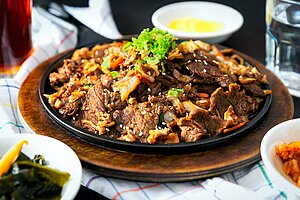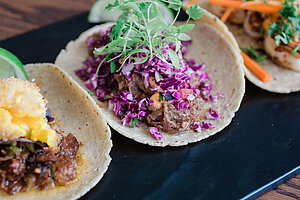 With flavors as rich as the culture that birthed them, it’s no surprise that Korean ingredients are catching on around the world. But as consumers explore Korean cuisine in America and beyond, you might worry that your own offerings will end up getting left behind.
With flavors as rich as the culture that birthed them, it’s no surprise that Korean ingredients are catching on around the world. But as consumers explore Korean cuisine in America and beyond, you might worry that your own offerings will end up getting left behind.
Not to worry. We’re here to help you get up to speed on the most popular modern Korean food trends, including gochujang, gochugaru, kimchi, red bean paste, and more. If all this sounds like Greek (or, well, Korean) to you, get ready for a crash course on Korean flavors that’ll teach you everything you need to know to keep your customers coming back for a second helping.
Along the way, you’ll discover a bit more about why Korean food culture deserves this long-awaited moment in the spotlight and what the rest of the world can learn from their exciting flavor combinations.
Inside the Rising Demand for Korean Food Imports
Korean flavors have been represented in U.S. cuisine for as long as Korean people have lived here. That means that for well over a hundred years, Korean Americans have been adapting and refining their own food culture distinct from other Americans and from Koreans back home. You can see evidence of this in the many restaurants, food trucks, street stalls, and food-centric establishments in Korean neighborhoods across the country–from New York City to Los Angeles and plenty of places in between.
So now you know that the history of Korean cuisine in the U.S. runs a lot deeper than you may have originally thought. But that doesn’t completely explain the recent surge of interest in Korean and Korean-inspired flavor concepts. Why exactly do consumers find current Korean food trends (and Asian food trends in general) so appealing?
Well, as we discussed in our breakdown of Gen Z flavor preferences, this historically diverse generation is dedicating its growing purchasing power to pressing for more authentic and ethnically varied food trends. You’ll need to be willing to look beyond traditional American flavors to create culinary experiences that’ll keep attracting new customers for years to come.
The 4 Latest Korean Food Trends in the U.S.
Gochujang
Gochujang, also called Korean red chili paste, is a fermented spicy condiment and one of Korea’s most popular flavors. Made from sticky rice, Korean chili powder, fermented soybean, barley malt, salt, and other seasonings, gochujang boasts a complex flavor profile that mixes sweet, savory, and varying amounts of heat.
Never tried gochujang? You can compare its flavor to other spicy-sweet sauces from around the world, like sriracha or sambal.
You can find gochujang in some of Korea’s most loved dishes, including:
-
Bibimbap: A bowl of warm white rice topped with vegetables, eggs, or meat
-
Bulgogi: Grilled, marinated slices of meat, usually sirloin, rib eye, or other cuts of beef
-
Tteokbokki: Stir-fried rice cakes served with boiled eggs, scallions, or fish cakes
Gochugaru
Gochugaru is also called Korean chili powder, and that's a pretty self-explanatory name. This powder is made from sun-dried Korean hot peppers, a relatively low-heat variant of the chili pepper plant.
If you’ve never tried gochugaru before, you can expect a texture that’s not quite as fine as chili powder but also not as chunky as red pepper flakes. Its flavor is also less one-note than the chili powder you might be used to, with sweet and smoky notes balancing out the heat. That complexity is key to achieving authentic Korean BBQ flavors.
You can find gochugaru in these Korean dishes:
-
Gochujang: Gochugaru is a key ingredient in the condiment we just discussed, lending gochujang its trademark spiciness
-
Kimchi: A wildly popular side dish made from fermented vegetables
 Kimchi
Kimchi
Even if you know almost nothing about Korean cuisine, you’ve probably heard about kimchi. It’s a side dish made from seasoned and fermented vegetables, usually cabbage or radish, as well as salted seafood known as jeotgal.
If you’ve made it this far without ever tasting kimchi, you can consider it somewhat comparable to sauerkraut (if sauerkraut were a little spicy). That spice comes from — you guessed it — gochugaru, along with garlic, ginger, and other seasonings.
Here are just a couple of the many Korean dishes that feature kimchi:
-
Kimchi jjigae: Also called kimchi chigae or kimchi stew, this soup stars kimchi along with pork, tofu, scallions, and onions
-
Sundubu-jjigae: Another Korean stew combining extra soft tofu, vegetables, kimchi, and sometimes meat or seafood
Related: Japanese Food Trends Hitting the U.S. Markets
Red Bean Paste
Also called red bean jam, this paste is made from boiled and mashed adzuki beans. Red bean paste is found in plenty of East Asian cuisines, but in Korea it’s typically sweetened with sugar or honey to create a smooth red confection known as danpat or danpatso.
If you’ve never had red bean paste, keep in mind that it doesn’t taste like kidney beans. Even when unsweetened, red bean paste tends to have a mildly sweet flavor.
You can sample red bean paste in any of these dishes:
-
Chalbori-ppang: A South Korean sweet made from two barley pancakes filled with red bean paste
-
Chapssal doughnuts: Korean doughnuts made from sticky rice flour and filled with sweetened red bean paste
-
Patbingsu: A milk-based shaved ice dessert often made with and topped with red beans
 Korean Flavors Making Waves in the U.S.
Korean Flavors Making Waves in the U.S.
Now that you have a sense of what exactly makes these Korean dishes so well-loved, let’s zoom out to give you a bigger picture of how Korean flavors fit into global food and beverage trends. With this knowledge, you’ll be ready to start incorporating Korean-inspired flavors into your own offerings.
Stay Informed, Stay Inspired - Subscribe to our Newsletter Here!
Beverage Trends
When it comes to trends in the beverage industry, the last few years have been transformative. With health concerns on the rise, consumers have been seeking out drinks that boost immunity and reduce inflammation, preferably with natural ingredients.
These health-conscious Korean drinks could help you come up with some new flavor ideas for your own beverage offerings:
-
Banana milk
-
Barley tea
-
Ginseng tea
-
Soju
Dessert Trends
Even when modern consumers are looking for a bit of premium indulgence, the latest flavor trends toward sustainability and health still apply.
Sample these Korean desserts made with medicinal ingredients for some sweet and healthy inspiration:
-
Baesuk (poached pear)
-
Hkmi Chal Ddeok (black rice cakes)
-
Yaksik (sweet rice cakes with dried fruit and nuts)
Summer Flavors
In the summertime, customers without the means to travel will be looking for global flavors that let them experience the world from home.
Let these Korean warm-weather offerings inspire you to create summertime treats that provide new culinary and emotional experiences:
-
Korean watermelon punch
-
Melona (honeydew melon ice pops)
-
Patbingsu (shaved ice)
Winter Flavors
When colder weather arrives, flavor trends tend to shift toward familiarity and comfort in the fall and immune-boosting ingredients for winter.
These Korean winter favorites will help you zero in on the top flavors for colder weather:
-
Bungeoppang (fish-shaped winter pastry)
-
Hobakjuk (Korean pumpkin porridge)
-
Hotteok (sweet pancakes)
Get More Consumer Insights for Food and Beverage
Feeling hungry for more flavor insights that’ll take your culinary brand to the next level? Get all the latest news and trends in the food and beverage industry right here at In-Sight.






